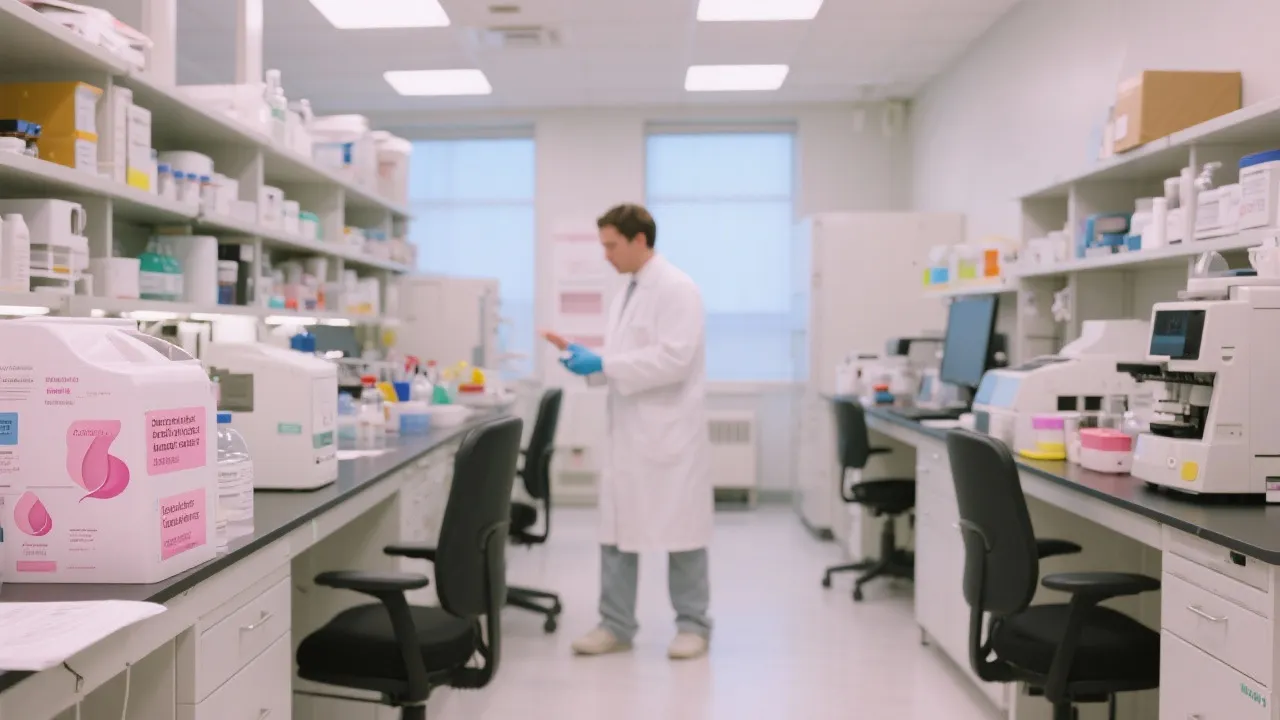Understanding Cyp Breast Cancer
Cyp Breast Cancer refers to cases where specific cytochrome P450 enzymes are involved in the development or treatment of breast cancer. These enzymes, central to drug metabolism and hormone biosynthesis, can impact how breast cancer develops and responds to therapy. This comprehensive guide delves into the role of Cyp enzymes in breast cancer, exploring their significance in diagnostics and treatment strategies.

Introduction to Cyp Breast Cancer
In the complex world of breast cancer research, cytochrome P450 enzymes (CYP) have emerged as pivotal players. These enzymes are integral to the metabolism of various substances within the body, including hormones and drugs, which are crucial in the context of breast cancer. Through detailed exploration, this article seeks to provide a thorough understanding of how CYP enzymes influence breast cancer treatment and management.
The Role of CYP Enzymes in Breast Cancer
CYP enzymes are primarily involved in the metabolism of estrogens and the activation of procarcinogens that influence cancer pathogenesis. Their role varies significantly, with some enzymes contributing to the detoxification processes, while others may activate carcinogenic compounds. In breast cancer, the CYP1A1, CYP1B1, CYP2D6, and CYP3A4 are among the most studied due to their impact on drug metabolism and hormone regulation.
CYP1A1 and Its Role in Hormone Regulation
CYP1A1 is significantly involved in the metabolism of estrogens. Higher activity levels of CYP1A1 can lead to increased estrogen metabolism, which may have both beneficial and detrimental effects in the context of breast cancer. On one hand, the detoxification of estrogen may lower its potential carcinogenic effects; on the other hand, excessive byproducts produced through its metabolism can lead to DNA damage, contributing to oncogenesis. The balance of these processes makes CYP1A1 an important focus for breast cancer research, particularly in understanding risk factors associated with estrogen exposure.
CYP1B1 and Carcinogen Activation
CYP1B1 has garnered attention due to its role in the metabolic activation of polycyclic aromatic hydrocarbons (PAHs), which are environmental carcinogens. Its expression is notably elevated in breast cancer tissues compared to normal tissues, indicating a potential link to carcinogenesis. Studies suggest that CYP1B1 is involved in the activation of various carcinogenic compounds, which may contribute to tumorigenesis. Furthermore, its products may damage cellular macromolecules, including DNA and proteins, further exacerbating cancer progression. Targeting CYP1B1 presents a promising avenue for therapeutic intervention and may help in developing strategies to prevent or treat breast cancer.
CYP2D6: Drug Metabolism and Treatment Response
CYP2D6 is a major enzyme in the metabolism of tamoxifen, one of the most commonly used adjuvant therapies for hormone receptor-positive breast cancer. The variability in CYP2D6 activity due to genetic polymorphisms can have significant clinical implications; patients classified as "poor metabolizers" may not convert tamoxifen into its active metabolite, endoxifen, leading to suboptimal therapeutic effects. As such, pharmacogenetic testing for CYP2D6 can provide essential insights that enable oncologists to customize treatment plans based on a patient’s specific metabolic capacity, potentially improving overall outcomes and reducing the risk of recurrence.
CYP3A4 and Drug Interactions
CYP3A4 is one of the most abundantly expressed CYP enzymes in the liver and is crucial for the metabolism of various anticancer drugs, including aromatase inhibitors and certain chemotherapeutics. It is also involved in the metabolism of numerous medications, which can lead to significant drug interactions. Patients undergoing breast cancer treatment must be monitored closely for potential interactions that may either enhance toxicity or reduce therapeutic effectiveness. A thorough review of all medications, including over-the-counter drugs and supplements, is vital to avoid adverse drug reactions and ensure optimal management.
Significance in Treatment
Understanding the function of CYP enzymes in breast cancer is crucial for personalized medicine. For instance, CYP2D6 metabolizes tamoxifen—one of the most common drugs used in breast cancer therapy—into its active form. Variability in CYP2D6 activity can significantly affect drug efficacy and patient outcomes. Patients with certain genetic polymorphisms may experience altered drug metabolism leading to variations in therapy effectiveness and adverse effects.
Diagnostic Implications
The presence and activity level of specific CYP enzymes can serve as biomarkers for breast cancer progression and treatment response. For example, higher expressions of CYP1B1 have been linked to unfavorable prognosis due to its role in activating potential carcinogens. These insights allow oncologists to refine treatment plans and identify high-risk patients who may require more aggressive or tailored therapeutic strategies. The emerging concept of biomarker-driven treatment protocols not only enhances therapeutic efficacy but also reduces unnecessary interventions, aligning treatment with the biological characteristics of the tumor.
| CYP Enzyme | Impact on Breast Cancer | Therapeutic Relevance |
|---|---|---|
| CYP1A1 | Involvement in estrogen metabolism and carcinogen activation | Potential target for biomarker research |
| CYP1B1 | Linked with poor prognosis and drug resistance | Investigated as a therapeutic target |
| CYP2D6 | Metabolizes tamoxifen to its active form | Prevalent in breast cancer treatment personalization |
| CYP3A4 | Involved in the metabolism of cancer-fighting drugs | Essential for dosing considerations in pharmacotherapy |
Frequently Asked Questions (FAQs)
Q: How do CYP enzymes affect breast cancer therapy?
A: CYP enzymes significantly influence the effectiveness of breast cancer therapies by altering drug metabolism and hormone regulation, impacting treatment outcomes.
Q: Can the presence of certain CYP enzymes serve as a diagnostic tool?
A: Yes, the activity of specific CYP enzymes can act as biomarkers for breast cancer progression, aiding in diagnostics and treatment decisions.
Q: Are genetic tests available to determine CYP enzyme activity?
A: Genetic tests are available that can predict enzyme activity, helping to tailor breast cancer treatment plans to individual patient needs.
Future Perspectives
As research continues to explore the multifaceted roles of CYP enzymes in breast cancer, promising strategies for improving patient outcomes are on the horizon. The integration of pharmacogenomics into routine clinical practice is paving the way for customized treatment regimens. By simultaneously analyzing the genetic profile of both patients and tumors, oncologists can devise more precise treatment plans that not only consider drug interactions and side effects but also the unique biology of each patient's cancer.
Emerging Biomarkers and Therapeutic Targets
The study of CYP enzymes is unveiling new potential biomarkers that could refine prognostic assessments. For instance, the expression levels of CYP enzymes can provide insights into tumor behavior and may guide decisions related to the aggressiveness of treatment selected. Moreover, novel inhibitors targeting overactive CYP enzymes may serve as adjunct therapeutics, particularly in cases of resistant breast cancer types. By honing in on the enzyme's role in drug metabolism and activation of carcinogens, researchers are conceptualizing combination therapies that can enhance treatment efficacy while minimizing resistance development.
Clinical Trials and Research Initiatives
A number of clinical trials are already investigating the implications of CYP enzyme activity in various breast cancer therapies. These trials are critical not only for validating the role of CYP enzymes in predicting treatment responses but also for assessing their potential as therapeutic targets. Prospective cohort studies that track outcomes based on CYP polymorphisms are essential for understanding the broader implications of genetic variability in treatment efficacy and safety. Such research holds the promise of identifying the most effective therapeutic strategies for individual patients based on their unique genetic profiles.
Environmental and Lifestyle Factors
In addition to genetic factors, environmental influences and lifestyle choices can significantly impact the activity of CYP enzymes. Factors such as diet, smoking, and exposure to environmental pollutants can all modulate the expression of these enzymes, thus affecting individual cancer risk and treatment response. Ongoing studies aim to discern these relationships further, offering insights into preventive measures that can reduce cancer risk while also exploring how lifestyle modifications may impact enzyme activity and, subsequently, therapeutic outcomes.
Education and Awareness
As our understanding of CYP enzymes in breast cancer treatment deepens, there is an urgent need for enhanced education among healthcare professionals. This education should encompass the implications of using pharmacogenomic data in clinical decision-making, the significance of enzyme activity in individualized treatments, and the potential risks of drug interactions. By fostering a comprehensive understanding of these enzymes, clinicians can better advocate for their patients, ensuring they receive tailored and effective breast cancer care.
Through an enriched understanding of CYP enzymes, the future of breast cancer treatment looks increasingly personalized, with the potential for improved patient outcomes. Ongoing research continues to unravel the complexities of CYP involvement, promising new directions and refinements in breast cancer management strategies. The pivotal role of CYP enzymes not only underscores the importance of individualized treatments but also highlights the necessity of continuing education and research to optimize breast cancer therapy. As scientists, oncologists, and healthcare teams collaborate, the endeavor to offer precision oncology to patients is firmly within reach.





